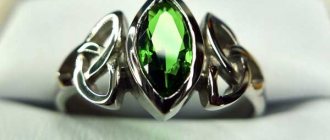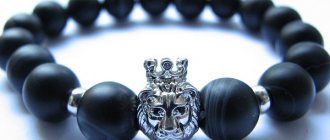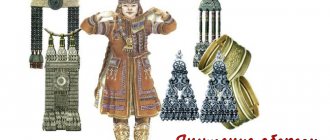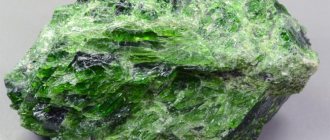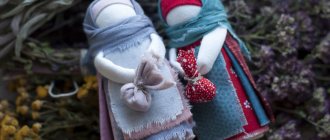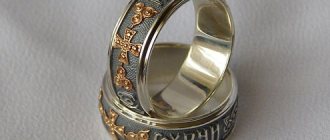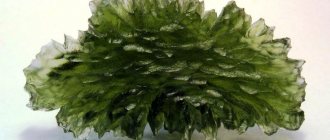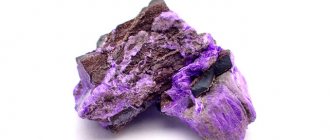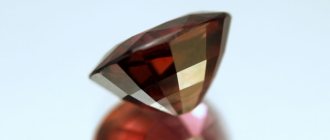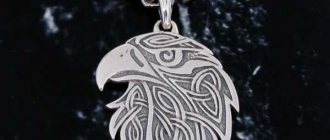Yakut amulets (Kharyskhal) are beautiful and unusual. They protect families and homes from damage, the evil eye, and dark energy. The Yakuts live in harmony with nature and respect its laws. Therefore, most talismans are made from natural raw materials. Sacred ornaments can be found on clothing, hats, jewelry, household items and in the interior.
ATTENTION! If a person wears an imperial amulet on himself, he will never be poor. His debts are closed and a streak of luck sets in, which brings him into a comfortable life. With an imperial amulet, money will come in abundance - there will be much more of it than you expect... Read more"
What are they, Yakut amulets
The Yakuts are close to nature, they live in harmony with it, obey its laws, and treat the power of the elements with awe and respect. Almost all talismans used by the Yakuts are made from natural materials. These include:
- bones, fangs, claws and animal skins;
- silver jewelry;
- wooden miniatures of household items;
- stones;
- ornaments embroidered with beads or thread.
Magical objects protected from the evil eye, damage, spirits, from the influence of the elements, preserved health, and attracted good luck.
Yakut jewelry and patterns are of greatest interest to ethnographers, since they protect and carry information about a person’s status, social role, well-being, and desires. For example, the choron, a Yakut vessel for kumys, is used in deity worship and blessing. Decorations are applied to it depending on the request raised to the gods. The role of inheritance of amulets is important. The older they were, the higher the strength. A resident of the city of Nyurba says:
“When I was little, my grandmother had silver earrings with 3 rows of pendants. Grandmother treasured them very much. And now I am a grandmother myself and wear her earring. Girls very rarely wore all the jewelry - only for weddings and Ysyakh. At Ysyakh, a girl’s position in society was determined by her jewelry. Then they were very expensive, not every girl could afford them. Since my youth, Yakut products have changed a lot. Previously, there were only plates and engravings on them. I think this shows the cultural development of the people.”
Ornaments are applied to Yakut clothing to protect against evil forces, so embroidery is used to decorate the weakest places through which spirits can penetrate: the hem, sleeves, collar, belt, spine.
The main motifs are plant-based, suitable for everyone, symbolizing development and fertility. When choosing a pattern, you need to consider the following features:
- the lyre-shaped pattern is not suitable for girls and grandmothers;
- a plant sprout for small children, a bud for older boys and girls, blossoming flowers for older ones;
- the ornament should have tended upward, not downward.
Men's clothing was traditionally decorated with five rhombuses combined into one. This is a symbol of perfection, a combination of five elements: water, air, wood, fire, metal. In the center of the rhombus, the circle is the feminine principle, since the man is inseparable from the woman.
Charm Kharyskhal
Another traditional motif resembles yin-yang, but with three divisions. It symbolizes three souls: mother, earth, air.
Metal items were put on or amulets were sewn onto the locations of the main chakras. This is the solar plexus, forehead, hips, belt, heart area. For example, from the inside out, opposite the heart, the face of a small animal was hemmed. On the caps, a metal plate was placed in the center of the forehead.
Talismans were originally made from any metal; blacksmiths did this. They were revered on a par with shamans. Rich families had their own personal master.
Later they began to be made exclusively from silver; gold was not used. Silver has cleansing powers and drives away spirits.
Wedding attire stands out especially since the bride is the successor of the family, and the well-being of the family and the health of the children depend on her. Every detail mattered. Most of them drove away evil spirits and the evil eye, the other side was aimed at strengthening reproductive function.
A wedding suit consists of the following fragments:
- headdress;
- earrings;
- chest set;
- back set;
- bracelets.
The weight of the decoration could reach tens of kilograms. The dowry was prepared from the very birth of the daughter, making one piece of costume per year. By the age of majority, a full dress had accumulated.
Everyday items were more modest. The main types include:
- Earrings. They started wearing them at the age of five. The shape of the earrings resembled the figure of a girl, and the details were a message to others, informing others about the status of their owner. For example, girls wore flat, one-piece figures. A hole in the center indicated married status. Earrings in the shape of a lyre with pendants were worn by women with many children. An aging woman takes off her pendants and gives them to her granddaughter as a sign of continuation of the family line.
- Bracelets. In addition to protective functions, they have a practical one. They fasten the sleeves of clothes with bracelets to keep out the cold.
- Belt. He did not allow spirits to penetrate the body, so only shamans could walk without belts. Adults richly embroidered their belts with ornaments, and children girded themselves with rope.
Men, women and children used different talismans because their social functions differed.
Yakut jewelry: from handicraft to global brand
YAKUTIA.INFO. Yakut jewelry has won the right to be called the most striking brand of the republic. And not only on a Russian, but also on a global scale. For many, this is already a matter of course.
However, if you think about it, how much of a journey preceded this? And how did the Yakut jewelry industry from small handicraft production become the leader of our economy?
About this on the eve of the Day of Workers of the Cutting and Jewelry Industry of Yakutia, celebrated on October 23, in the material Yakutia.Info .
Centuries-old traditions
Tatyana Kyrbasova
The cutting and jewelry industries in Yakutia are related industries. But if Yakut lapidary is a relatively young industry and appeared in the 90s, then the answer to the question - when the Yakuts began to engage in jewelry - is the subject of archaeological science.
The granilka appeared thanks to sovereignty, when Yakutia had access to its diamonds. When, thanks to the friendship of Mikhail Nikolaev with Boris Yeltsin, diamond rain fell on us.
The cutters themselves say correctly that now the cutting industry is the only chance that HAS NOT BEEN MISSED. And there were a lot of them... Antique women's jewelry
“As for the Yakut jewelry industry, we are talking about the centuries-old traditions of Yakut jewelry. Archaeological science has proven that the Sakha people arrived on the territory of present-day Yakutia, already mastering the blacksmithing and jewelry business, which was developed at that time. This can be confirmed by the finds of ancient women's silver jewelry in burials and horse jewelry dating back to the 12th century AD. One of the realistic versions is that the victorious conquest of such a large territory was facilitated by the perfection of blacksmithing by the Sakha people. After all, the arrowheads, spears, batas were metal, and not bone like those of the aborigines? The more developed people replaced the less developed ones. Innovation played a decisive role. And the jewelers were, of course, the elite of Yakut blacksmiths,” says Tatyana Kyrbasova, .
In Soviet times, Yakut jewelry not only did not develop, it survived. Large state enterprises, which were located in every region of the YASSR, were engaged in precious metals and stones. I remember when master jewelers came to our village, all the women went to them to melt the same type of earrings and rings bought in stores into the national Yakut ytar5a - pendants in the form of a stylized woman and signets with a choron and sardana, etc. Thanks to these workshops jewelers have carried on the centuries-old traditions of their ancestors to the present day,” says Tatyana Petrovna.
Hard to learn, easy to fight
The fall of the USSR and the times of sovereignty served as an impetus for the development of the jewelry industry. The most important thing appeared - the market, and with it the desire of entrepreneurs to invest in jewelry. Thus, the jewelry direction “Gold of Yakutia”, coming from the “Sardana” factory and the workshops of “Rembyttekhnika”, has expanded. Taras Gavrilyevich is considered the founder of a new round of development in the jewelry industry . The first entrepreneurs to invest in the industry were Vasily Alekseev (“Sakhayuvelir”) and Alexander Pavlov (“Kierge”).
“It was an interesting time”
The conditional next stage in the development of jewelry can be called the period when eminent piece jewelers who worked in large jewelry enterprises began to create their own jewelry companies. This is Luka Egorov , who created “Uranus Sakha”, the Osipov - “Simekh”, the Zabolotsky brothers - “Ohuor utum”, Gavril Everstov - “Ayar Uus”, Yuri Ivanov - “Pearls”, later they were joined by Alexander Timofeev , “Sakha Design". This is the “golden fund” of the author’s Yakut jewelry. It was they who preserved, developed in Yakutia and promoted traditional Yakut jewelry to the Russian market.
“I would also like to highlight Stepan Nikolaevich Popov , Ivan Alekseevich Zakharov , Nikita Kapitonovich Naumov and other original talented jewelers,” says Anatoly Nikiforov , head of the EPL jewelry alliance. “I was not only a witness, but also participated in all this. It was an interesting time."
This was the time of his formation as a jeweler, which, however, is typical for many. Since childhood, like many Yakut children, Anatoly Nikiforov showed creative and artistic abilities. He painted, made a lot, and took part in exhibitions.
The saying “a difficult childhood means wooden toys” is about the Soviet childhood of Anatoly Lukich. However, this was only for the good. “Before there were no toys, so we made them ourselves from a wooden core of thread,” he says. - Or, you pick out a mold of a hare or a dog in a brick, and pour lead into it. It turns out to be such a heavy, massive toy,” the jeweler recalls his childhood.
Then there was the army. In the army, like many Yakuts, Nikiforov was quickly appreciated for his talent as an artist. “Who works as a clerk in the army for good handwriting? Who draws demobilization albums well? Yakuts. All Russian boys know this. This is a natural talent,” says Anatoly Lukich.
Then SPTU-16, specialty of jeweler-mounter, Yakut State University, Department of Jewelry Technology.
Anatoly Nikiforov (right), the beginning of the journey
Yes, the traditions have been preserved. But in the 90s, during the period of market development of the industry, it was very difficult. According to Anatoly Lukich, at first they were guided by a simple rule - sell everything that glitters. This is understandable: in the 90s there were neither tools nor information on how to work correctly. Therefore, I had to comprehend a lot on a whim, by trial and error. Jewelry was made using a semi-handicraft method: molds were made of clay and silver was poured into it.
Jewelry developed rapidly. First steps, success, first serious dividends, expanding horizons.
Large companies now have the opportunity to send their specialists for internships not only in Russia, but also abroad. So, our Anatoly Lukich remembers with gratitude his internship in Italy from “Gold of Yakutia”, in the city of Italian jewelers Vicenza. But Lukich’s finest hour, as the jewelers now call him, has not yet struck. Little did he know that this would be connected with the parallel developing cutting industry.
“A jeweler should be a psychologist”
Jewelry art is based on a natural sense of beauty, harmony, and lines. But instinct alone is not enough - to become a master, you need daily work.
“A jeweler is like a melodist; you are constantly, every day, in a creative search. Like in that advertisement: you suffer, you wait,” Lukich laughs. “You even get on the bus and involuntarily start looking around to see what kind of jewelry the women are wearing.” You come home late in the evening, sit, eat, and think about the unfinished product. There’s a thought in my head: I wish I could go to bed sooner so that I could get up and sit down at the workbench sooner. This is already fanaticism, and it’s not about money, but about creative expression. And that’s the greatest pleasure.”
According to Lukich, the main principle of a jeweler is to create exactly his product for the customer. The question is how to guess the hidden spiritual currents of a person and at the same time make a beautiful thing that is in tune with his taste, with his inner world.
“If you work directly with the customer, this is the best school,” says the jeweler. – You are not only the person who makes the decoration. Are you a psychologist. You look at how, say, a woman talks, how she is dressed, you talk with her and you feel: such and such jewelry will suit her. And if I calculated everything correctly, the next day she comes and says - how beautiful! And this is the greatest happiness!”
The main principle of a jeweler is to create exactly his product for the customer.
Of course, young and inexperienced people do not immediately succeed in this. But this comes with time.
Merger with the cutting industry and what came of it
But just making a good product is not enough - you also need to be able to present it and sell it profitably.
In Yakutia, the production of the jewelry industry remained at the same level for a long time, not exceeding 600-700 million rubles per year. It seemed that there was a ceiling - well, the jewelers could not overcome it. The then president of the republic, Vyacheslav Shtyrov, wondered why the industry is always marking time in one place? How to give it an impetus?
And a turning point occurred. “It was a quantum leap. This happened in 2006-2007, when EPL Diamond took up the jewelry business,” recalls Tatyana Kyrbasova. – Until this time, the cutting industry developed on its own, exporting diamonds to Israel, Belgium, India, and America. And as soon as the Yakut jewelry industry, represented by EPL, switched to the production of diamond jewelry, there was a sharp leap in the development of the republic’s jewelry industry. It was a completely new direction."
Presentation of the jewelry workshop (2009)
A new stage has begun - mass production of jewelry with diamonds. The head of EPL, Pyotr Fedorov, took on the task of building a completely new design for the jewelry business, capable of not only catching up and surpassing the famous Russian jewelry centers - Kostroma, Kusa, but also competing with global jewelry brands. In principle, the ambitions were not unfounded - its cutting production was already producing world-standard diamonds.
It was 2007. Fedorov scrupulously recruited a team of professionals.
“In 2007, by the will of fate, I came to EPL Diamond with a request to finance a jewelry workshop,” says Lukich. – I was lucky that I was received by Pyotr Fedorov himself (founder and chairman of the board of the EPL group of companies - author). We talked. They immediately understood each other, like a production worker and a production worker. I entered into an agreement with EPL, bought the most advanced jewelry equipment at that time, recruited personnel and away we go! This was completely new in Yakut jewelry - mass production of diamond jewelry! Along with mass production, we began producing exclusive diamond jewelry! Large orders began to arrive, many of which are exhibited in the Treasury of Jewels of Yakutia. For example, we made the large panel with diamonds that stands in the Gokhran of Russia.”
When the historic milestone of 1 billion rubles in sales was reached in 2010, jewelers and EPL sellers staged fireworks along Oyunsky Street. In general, the industry sold about 1.5 billion Yakut jewelry. Then the marks of 2.3 billion were taken. And last year 2014 there were already over 4 billion rubles.
Today, according to the Industrial Production Index (IPI), jewelry and cutting machines occupy 5th place after large raw materials industries - oil and gas, diamond mining, gold mining and coal.
Independence is good
The question is, what's next? All jewelers dream of Yakutsk becoming a world jewelry center. Everything is moving towards this step by step. Yakut residents proudly received the news about the opening of EPL jewelry stores in Vienna, Berlin, Zagreb and a number of cities in Kazakhstan this year.
Salon in Berlin
If the Guild of Jewelers of Russia notes a sharp decline and decline in the Russian jewelry industry, then they also note stability and even growth in the jewelry and cutting industry of Yakutia. and this despite the all-Russian crisis.
Small and medium-sized entrepreneurs from the jewelry and lapidary industries note that during a crisis, support from the state would not be superfluous, for example, in terms of providing raw materials.
But there is none of this. However, perhaps this is beneficial. After all, it was the independent overcoming of difficulties that made private traders strong. “EPL”, “Uran Sakha”, “Ohuor Utum”, “Simekh”, “Sakha Design”, “Ayar Uus”, “Pearl” and others - the list of industry heroes is quite wide. These companies, which did not receive a single ruble from the state, achieved everything with their talent and labor, and raised the jewelry industry.
Opening of a salon in Astana, Kazakhstan
The good news is that every year more and more young people want to become entrepreneurs, jewelers and lapidaries. They have before their eyes the successful example of their older brothers, fathers - the Fedorovs, Egorovs, Osipovs, Zabolotskys and others, known throughout the republic. Among the winners and prize-winners of all-Russian jewelry competitions there are many new names of young masters.
“Young people see that by becoming a great cutter or jeweler you can gain independence and live a normal life thanks to your work and talent. That’s why they come to our industry. It is in the training of personnel, and then in retaining personnel after study, that support from the state is primarily needed. For some reason, there is a program to support young professionals in the public sector with housing at the expense of the state, but sometimes we lose real young talents due to poor living conditions,” says Tatyana Kyrbasova.
Amulets for children
It is customary to protect a child even before birth. The moment of birth is especially dangerous, when evil spirits can harm the baby and mother, so the birth was accompanied by numerous talismans that preserve the life of the baby and alleviate the suffering of the mother.
The patroness of fertility, protecting the woman in labor - Aiyysyt. She was symbolized by the skin of a hare. Threads of beads were threaded through the eye sockets, and earrings were put into the ears. During childbirth, the skin was generously oiled.
Earrings, a bit, and a whip were hung over the bed of a woman in labor to reduce pain and for a successful outcome. A circle was drawn around the bed with a birch stick, since the birch tree contains the spirit of the mistress of the area; not a single representative of the other world could cross such a line.
After the baby was born, a knife was stuck into the stick that the woman was holding on to if a boy was born, or scissors if a girl was born.
In the first year of life, a baby cannot yet resist evil on his own, so he is hunted by the soul eaters of Abaasyt. They were driven away by tying a knife in a sheath, a flint, a hatchet, a bear's paw, and a sable skull to the sides of the crib.
Rings, metal plates and other ringing objects were sewn onto the blanket. A child who began to crawl and walk had a bell tied to his back. By ringing, he cleared the room of bad energy, scared away spirits and told the mother where the baby was.
For a good night's sleep, a hare's foot was sewn into the corner of the pillow.
From infancy until the end of his life, a person kept a bag made of taimen leather “Ogo kuta”. It contained 10 umbilical cord bundles and hair. This is the concentration of life force.
Grown-up children wore earrings, pendants, and metal plaques with designs and beads. A traditional amulet for a boy is a bow and arrow. This is the concentration of masculinity, the moral and physical qualities of the future man.
Women's mascots
They are aimed at maintaining health, strengthening the family, and developing intuition.
To facilitate breastfeeding, a smooth stone with a funnel-shaped hole in the center is used. It was customary to express milk through it.
A girl setting off on a journey made an amulet with her own hands from bear fur, reminiscent of a brush - moonnyoh. It was hung around a horse's neck to clear the way for spirits.
A girl of great age made a whip from willow branches, decorating it with figurines made of bone and silver. A bell was hung from the tip of the rod. After the baby was born, the whip was hung over the cradle.
A silver plaque, tuosakhta, symbolizing the sun, was worn on the caps. One of its meanings is protection against smallpox.
Girls wore earrings, rings and bracelets as jewelry. When walking, the decoration should jingle so that evil does not approach.
In addition to the hat, the protective headdress of the bastyng is a hoop. The plaques on it covered vulnerable parts: the forehead and temples.
Men's amulets
Men wore almost no jewelry. Embroidery and animal parts were used as talismans: heads, paws, claws, teeth, bones. It was believed that the qualities of a killed animal were transferred to the hunter who killed it. In addition, the Yakuts chose a totem animal for themselves. They associated themselves with him, adopting properties, and were protected.
Animal mascots helped to track and kill prey while hunting, while remaining invulnerable. The fur of a wolf or bear was considered a talisman against the evil eye and disease.
Another animal amulet is a necklace of noses. This part of the animal’s body had a soul, so the Yakuts collected the noses of small animals in bundles: sables, arctic foxes, foxes to attract good luck.
For a successful hunt, a talisman made from the skin, horn and jaw of a deer was used. This bundle contains the spirit of the patron of animals and hunting.
The most powerful talisman is the Sata stone. It was found in places where lightning struck, and it also originated spontaneously inside a horse, bull, bear, dog or wolf. They recognize him by his appearance. Sata resembles a miniature human head, where eyes, nose, mouth, and ears are visible. This stone is alive. To prevent the stone from dying, a girl should not touch it, a stranger should not look at it, and the stone should not remain naked. It was customary to keep the amulet wrapped in the fur of the animal that gave birth to it away from home. With the help of sat, the Yakuts changed the weather or tied them to a horse during travel so that it would not sweat and would not be bothered by gadflies.
The background to the appearance of silver among the Yakuts
Ethnographers wrote about the use of silver in Yakut jewelry that blacksmiths-chasers, in addition to iron, were engaged in processing low-grade silver, which from the 19th to 20th centuries they obtained from the melting of Russian coins. Various decorations, plates for belts, and horse harnesses were created from the resulting metal.
The early period of the Yakut people was of particular interest to scientists. The expedition found cash reserves, but on the one hand it was too large an amount for personal expenses, but too insignificant for trading capital. Researchers tried to unravel the mystery of what this money was actually needed for in areas where monetary currencies were practically not used. Researchers in the forties almost guessed that money was required for trade with the East (countries such as Japan or China), but then this assumption seemed too fantastic.
It has now become clear that considering coins only as money is not entirely correct, because they contain silver, therefore, in this case, coins can go along with other goods that were intended for exchange. These include axes, beads, cauldrons and other products. Most of the silver, it turns out, came from China. And this is confirmed by various documents drawn up during trade. In addition, they noted that in 1611, silver utensils intended for trade were brought to Surgut from China. China also supplied silver bars to Mongolia starting in 1613. Nowadays, a silver deposit is put up for sale in Yakutia; experts estimate the deposit as medium in terms of reserves. Many companies have applied to participate in the tender.
Modern amulets in Yakutia
Research shows that most Yakuts believe in the power of amulets and many keep them at home. True, many of them are a thing of the past. The most common:
- dishes and household utensils with ornaments;
- embroidery on national clothes;
- drawings of animals;
- bear paws;
- precious items.
The last type of amulet is especially interesting. The motifs remain the same: lyre, female figure, floral ornament. But jewelry has become refined, openwork and not so massive. Silver is being replaced by gold and precious stones.
Experts warn that there are many Chinese counterfeits of Yakut products on the market. They are cheaper, but do not carry spiritual value or protective meaning. After a few generations they will lose their beauty and value. It is better to give preference to traditional Yakut craftsmen who are familiar with the history, culture and traditions of the people.
About respect for the noble metal
The main material for jewelry used in Yakutia is silver. Copper was also used, but it was not so popular, and gold was not at all in honor. The latter metal was despised, considering that it was too similar to copper or tombac. The best and most worthy ancient jewelry contains 50% of the noble metal, but mostly Yakut silver contains 50.78% copper, 34.26% silver, 15.05% zinc.
But respect for silver things among this nationality developed due to trading with China, which paid in silver bars, which were an excellent basis for creating their own jewelry from such a rare material in Yakutia. A similar monetary system was used from the 16th to 17th centuries. But already in the 19th century, they began to import both sheet silver, which was considered Polish, and silver coins. In addition to metals, they supplied the people with all kinds of fabrics and materials that could be used by women for needlework.
The Yakuts were the first to deliver silver to the northern part of Siberia. It should be noted that, in addition to metal, they brought with them to the north the culture of their ancestors, previously unknown there. They brought vital sources such as horse breeding and dairy farming, as well as pottery and blacksmithing.
It is believed that the most respected craft among the Yakuts was blacksmithing. Blacksmiths were credited with even greater power than shamans, because the former knew how to subjugate metals and create silver things that were so revered among the Yakuts. Therefore, it should not be surprising that traces of the blacksmith and foundry industry could be found in all settlements. There are especially many of them along rivers such as the Botom and Lyutenge in the Lena Valley.
